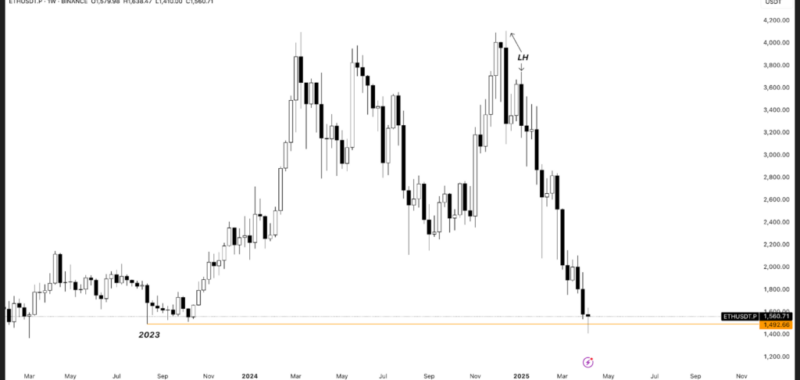Just before the futures market opened on Sunday, Ethereum dipped below the $1,600 mark and continued declining into the London session, hitting its lowest level since August 2023 at $1,450 per ETH. This move adds to the already bearish trend that has defined ETH’s price action since early January.
Source: TradingView (User – NoticeTrades) – Screenshot – @NoticeTrades
Don’t Miss:
The broader trend for Ethereum has been decisively bearish since January 6th, when the asset printed a lower high and failed to follow through with any meaningful continuation to the upside. Since then, ETH has been steadily grinding lower, reflecting both technical weakness and broader market uncertainty.
A large part of Ethereum’s appeal over the past several years has stemmed from its integral role in decentralized applications and, more notably, the non-fungible token market. However, the sharp decline in NFT trading volumes over the last year has removed a major pillar of support for ETH’s price. During the NFT boom, Ethereum benefitted from an influx of new users, higher transaction volumes, and increased gas fees — all of which contributed to demand for the token. As that wave has cooled, so too has enthusiasm for Ethereum as a utility-driven asset.
Source: Dune (User – @clot) – Screenshot taken by Nick Thomas
Trending: Hasbro, MGM, and Skechers trust this AI marketing firm — invest pre-IPO from $0.55 per share now.
Beyond NFTs, other fundamental narratives for Ethereum remain in place — including its role in decentralized finance, the ongoing development of Layer 2 scaling solutions like Arbitrum and Optimism, and the network’s reduced energy usage post-Merge. However, these developments have largely taken a backseat amid broader macroeconomic concerns.
Market sentiment across risk assets has deteriorated in recent weeks, and crypto, mainly altcoins, have not been spared. Escalating tensions between the U.S. and China over tariffs have reintroduced uncertainty across global markets.
Taiwan recently offered to drop tariffs entirely — a move that, while potentially stabilizing on the surface, may trigger a ripple effect as other countries reconsider their own trade strategies. The geopolitical climate has investors on edge, and crypto’s high beta nature makes it especially sensitive to shifts in risk appetite.

